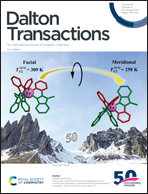Mechanistic study of the cooperative palladium/Lewis acid-catalyzed transfer hydrocyanation reaction: the origin of the regioselectivity†
Abstract
Density functional theory (DFT) calculations have been performed to gain insights into the catalytic mechanism of the palladium/Lewis acid-catalyzed transfer hydrocyanation of terminal alkenes to reach the linear alkyl nitrile with excellent anti-Markovnikov selectivity. The study reveals that the whole catalysis can be characterized via three stages: (i) oxidative addition generates the π-allyl complex IM2, followed by β-hydride elimination leading to the intermediate IM4, (ii) ligand exchange followed by Pd–H migratory alkene insertion gives the anti-Markovnikov intermediate IM6 and (iii) IM6 undergoes a reductive elimination step to form the linear terminal nitrile 3a and regenerates the active species for the next catalytic cycle. Each stage is kinetically and thermodynamically feasible. The oxidative addition step, with a barrier of 30.9 kcal mol−1, should be the rate-determining step (RDS) in the whole catalysis, which agrees with the experimental high temperature of 110 °C. Furthermore, the origin of the high regioselectivity of the product with excellent anti-Markovnikov selectivity is discussed.



 Please wait while we load your content...
Please wait while we load your content...